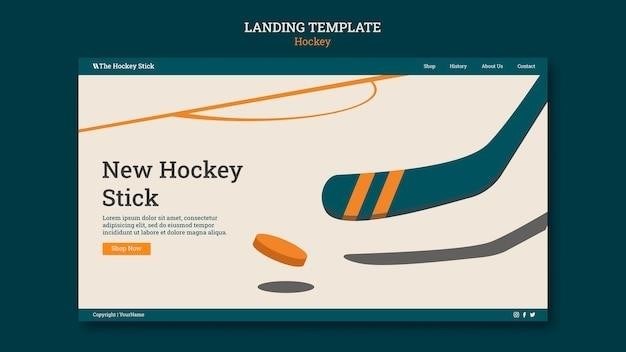
Field Hockey Stick Length Guide⁚ Finding the Perfect Fit
Choosing the right field hockey stick length is crucial for optimal performance and comfort․ A properly sized stick will enhance your reach, ball control, and overall gameplay․ This guide will help you navigate the factors that influence stick length, providing a comprehensive approach to finding the perfect fit for your game․
Importance of Stick Length
The length of your field hockey stick plays a pivotal role in your ability to control the ball, execute skills, and effectively contribute to your team’s strategy․ A stick that’s too short can hinder your reach, making it difficult to control the ball and pass accurately․ Conversely, a stick that’s too long can feel cumbersome and hinder your maneuverability, making it challenging to dribble and execute intricate stick skills․
A properly sized stick allows for a natural and comfortable grip, ensuring optimal control and balance․ It facilitates a smooth backswing, enabling powerful shots and accurate passes․ Furthermore, a well-fitting stick can reduce the risk of injuries, as it provides a secure grip and prevents unnecessary strain on your wrists and shoulders․
Ultimately, the right stick length empowers you to unleash your full potential on the field, allowing you to execute your game plan with confidence and precision․ It’s a fundamental aspect of your field hockey equipment that deserves careful consideration to ensure a seamless and enjoyable playing experience․
Factors Affecting Stick Length
The ideal field hockey stick length isn’t a one-size-fits-all solution․ Several factors influence the right choice, ensuring a personalized fit that complements your playing style and enhances your performance․ Height is a primary consideration․ Taller players often benefit from longer sticks, providing extended reach for ball control and passing․ Shorter players might prefer shorter sticks for greater maneuverability and agility․
Playing position also plays a role․ Defenders and midfielders often favor longer sticks for greater reach and power in driving the ball downfield․ Forwards, on the other hand, may prefer shorter sticks for better control and maneuverability in close proximity to the goal․
Personal preference is another crucial factor․ Some players prioritize a stick that feels comfortable and balanced in their hands, while others prioritize specific features like bow shape or weight․ Experimenting with different lengths and styles can help you find the stick that best suits your individual playing style and preferences․
Height-Based Stick Length Chart
A height-based stick length chart can serve as a starting point for determining your ideal stick length․ Keep in mind that these are general guidelines, and individual preferences may vary․ The chart below provides a recommended stick length based on a player’s height․ It’s important to remember that this chart is a guide, and individual preferences may vary․ Some players might prefer a slightly longer or shorter stick based on their playing style or personal comfort․
Remember that this is a general guide, and individual preferences may vary; Some players might find a slightly longer or shorter stick more comfortable depending on their playing style and personal preference․ Ultimately, the best way to find the perfect stick length is to try out different sizes and see what feels best for you․
| Height (Inches) | Recommended Stick Length (Inches) |
|---|---|
| 55 — 510 | 34 |
| 510 ⎻ 64 | 35․5 |
| 52 — 58 | 36 |
| 57 ⎻ 61 | 36․5 |
| 55 — 58 | 37 |
| 57 — 61 | 37․5 |
| 60 ⎻ 63 | 38 |
| 58, 62 | 38․5 |
Stick Length and Playing Position
Your playing position on the field can also influence the ideal stick length for you․ While height is a primary factor, different positions often require specific stick lengths to optimize performance․
Forwards, who typically operate closer to the goal, often prefer shorter sticks for better control and maneuverability․ A shorter stick allows for quicker stick handling and sharper turns, making it easier to dribble past defenders and create scoring opportunities․
Defenders, on the other hand, often benefit from longer sticks․ A longer stick provides greater reach, allowing defenders to effectively intercept passes, clear the ball from the defensive zone, and cover more ground on the field․ A longer stick also gives defenders a better advantage when tackling opponents and disrupting their attacks․
Midfielders, who are responsible for both attacking and defending, may prefer a medium-length stick․ This provides a balance between reach and control, allowing them to effectively transition between offensive and defensive roles․
Ultimately, the best stick length for your position will depend on your individual playing style and preferences․ Experimenting with different lengths and finding what feels most comfortable and effective for your game is essential․
Other Considerations for Stick Length
While height and playing position are key factors, several other considerations can influence your ideal stick length․ These factors can vary depending on individual preferences and playing style․
One important factor is the weight of the stick․ A heavier stick can provide more power but can also be more difficult to control․ Lighter sticks, on the other hand, are easier to maneuver but may not offer as much power․ Finding a balance between weight and control is crucial․
The bow of the stick, which is the curve in the shaft, can also affect stick length preference․ Sticks with a higher bow, meaning a more pronounced curve, tend to be longer than sticks with a lower bow․ A higher bow can provide more power and lift, while a lower bow offers better control and maneuverability․
Your playing style is another important factor․ If you are an aggressive player who likes to drive the ball hard, a longer stick might be preferable․ If you are a more technical player who prefers to dribble and pass, a shorter stick might be a better choice․
Ultimately, the best way to determine the ideal stick length is to try out different options․ Experiment with different lengths, weights, and bows to find what feels most comfortable and effective for your game․
Determining Your Ideal Stick Length
Finding your perfect field hockey stick length involves a combination of factors, including height, playing position, and personal preference․ While general guidelines exist, the best way to determine your ideal length is through a hands-on approach․
Start by standing upright and holding the stick in your dominant hand․ The top of the stick should reach roughly the level of your hip bone․ This provides a balanced starting point for most players․ However, adjustments may be necessary depending on your individual needs․
For players who prefer a more aggressive style and prioritize power, a slightly longer stick can be beneficial․ This allows for a greater reach and the ability to hit the ball with more force․ On the other hand, if you emphasize agility and close control, a shorter stick can enhance maneuverability and ball handling․
Experiment with different stick lengths to find what feels most comfortable and provides optimal control and power․ Take your time, and don’t be afraid to try out multiple sticks before making a decision․ Remember, the ideal length is a personal choice based on your individual playing style and body dimensions․
Tips for Choosing the Right Stick Length
Choosing the right field hockey stick length can significantly impact your performance and enjoyment on the field․ Here are some tips to help you make the best decision⁚
- Consider Your Height and Playing Position⁚ Generally, taller players will benefit from a longer stick, while shorter players may prefer a shorter stick․ Defenders often favor longer sticks for greater reach, while forwards might prefer shorter sticks for better control and maneuverability;
- Try Before You Buy⁚ Whenever possible, test out different stick lengths before making a purchase․ This will allow you to feel the difference in reach, balance, and control․
- Don’t Overlook Personal Preference⁚ Ultimately, the best stick length is the one that feels most comfortable and allows you to play your best․ Experiment with different lengths to find what works best for you․
- Pay Attention to Bow and Toe Designs⁚ The bow and toe designs of the stick can also influence its length and feel․ A more pronounced bow will typically result in a longer stick, while a straighter stick will be shorter․ Consider how these factors affect your reach and control․
- Factor in Your Skill Level⁚ Beginners may find it easier to control a shorter stick, while more experienced players may prefer a longer stick for greater power and precision․
- Don’t Be Afraid to Adjust⁚ If you find your current stick length isn’t working for you, don’t hesitate to try a different size․ The right stick length is an ongoing process, and it may take some experimentation to find the perfect fit․
By following these tips and considering your individual needs, you can choose the right field hockey stick length to enhance your game and maximize your potential on the field․
Choosing the right field hockey stick length is a crucial step in optimizing your performance and enhancing your enjoyment of the game․ By understanding the factors that influence stick length, including your height, playing position, and personal preference, you can make an informed decision that will empower you on the field․ Remember that there’s no one-size-fits-all solution, and finding the perfect fit may require some experimentation․
Don’t hesitate to try out different stick lengths, and don’t be afraid to adjust your choice if your current stick isn’t working for you․ The right stick length is an ongoing process, and it’s essential to find the size that feels most comfortable and allows you to play your best․ With a properly sized stick, you’ll gain greater reach, improved ball control, and enhanced power, giving you the confidence to dominate the field․
Remember that a well-chosen stick length isn’t just about finding the right size; it’s about finding the perfect tool to help you reach your full potential as a field hockey player․ So, take the time to find the perfect fit, and enjoy the benefits of a well-chosen stick on your journey to becoming a better player․
Resources
For a more in-depth understanding of field hockey stick length, consider exploring these valuable resources⁚
- Field Hockey Stick Size Chart — Osaka World⁚ This comprehensive guide provides a detailed stick length chart based on player height․ You’ll find helpful information on choosing the right stick length based on your height and position․ https://osakaworld․com/pages/size-guide-sticks
- Field Hockey Stick Size Chart & Guide — Net World Sports⁚ This resource offers a comprehensive guide to understanding field hockey stick length, including information on senior stick lengths and how to choose the right size for your needs․ https://www․networldsports․com/buyers-guides
- The REAL Field Hockey Stick Sizing Guide UPDATED — RAGE Custom⁚ This blog post presents a detailed and logical field hockey size chart based on player height, providing a valuable resource for finding your perfect stick length․ https://www․ragecustom․com/blog/the-real-field-hockey-stick-sizing-guide-updated/
- How to Choose a Field Hockey Stick ⎻ STX⁚ This guide from STX provides insights into the relationship between stick length, height, and personal preference․ https://www․stx․com/field-hockey/technology
- Explore a Range of Field Hockey Stick Sizes — Field Hockey Sticks USA⁚ This website offers a range of field hockey stick sizes, along with helpful advice on choosing the right length for your game․ https://www․fieldhockeysticksusa․com/which-size-field-hockey-stick-should-i-buy/
These resources provide valuable information and guidance on choosing the perfect field hockey stick length for your game․ Remember, finding the right stick length is an important step in maximizing your performance and enjoyment on the field․





